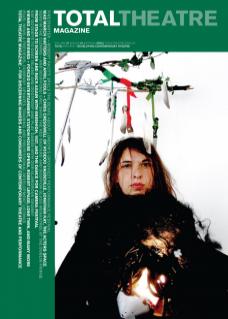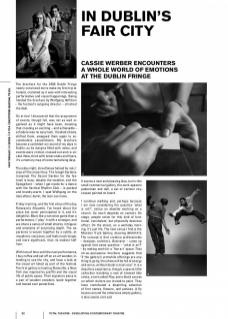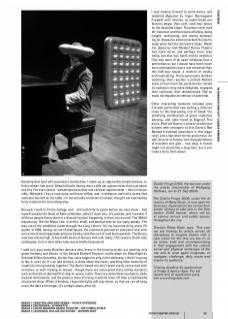The brochure for the 2008 Dublin Fringe nearly convinced me to make my first trip to Ireland, crammed as it was with interesting performative and visual happenings. Being handed the brochure by Wolfgang Hoffman – the festival’s outgoing director – clinched the deal.
On arrival I discovered that the programme of events, though full, was not as well organised as it might have been, meaning that creating an exciting – and achievable – schedule was no easy task. I booked shows, shifted them, swapped them again to accommodate cancellations. My brochure became a scribbled-on record of my days in Dublin, as its margins filled with notes, and events were circled, crossed out and re-circled. Now, thick with ticket stubs and flyers, it’s a memory map of some tantalising days.
Thursday night, streetlamps haloed by rain, I step off the airport bus. The Iveagh Gardens (renamed The Secret Garden for the festival) is busy, despite the weather, and the Spiegeltent – when I get inside for a dance with the Vertical Rhythm Club – is packed and brandy-warm. I spot Wolfgang on the dancefloor; damn, the man can move.
Friday morning, and the first show of the day, Rotozaza’s Etiquette. I’ve heard about the piece but never participated in it, and it’s delightful. More like a narrative game than a performance, I ‘play’ it with a stranger, and we share a series of small shocks, intrigues and emotions of surprising depth. The experience is woven together by a subtle, atmospheric voiceover, and feels much longer, and more significant, than its modest half-hour.
With lots of time until the next performance, I buy coffee and set off on an art wander, intending to see the city, and have a look at the visual art listed as part of the festival. The first gallery is hosting Skewville, a New York duo inspired by graffiti and the visual life of public space. Their signature piece is a pair of wooden sneakers laced together and tossed over powerlines.
It seems a neat and pleasing idea, but in this small commercial gallery, the work appears pedestrian and dull, a set of cartoon cityscapes painted on board.
I continue walking and, perhaps because I am now considering the question ‘what is art?’, notice an abseiler working on a church. So much depends on context. On stage, people strive for this kind of functional, nonchalant, but physically dextrous effect. On the street, on a workday morning, it’s just life. The next venue I find is the Monster Truck Gallery, showing IMMATATE. The concept is that creative professionals – designer, architect, illustrator – come up against that same question – ‘what is art?’ – by making work for a ‘fine art’ space. That oh-so-persuasive brochure suggests that “if the gallery’s erstwhile offerings are anything to go by, this show will be full of energy and verve, without doubt a must-see”. It is a desultory experience, though, a sparse little collection including a rack of chewed lolly sticks, a tent called Play, and a blank canvas on which visitors are invited to paint. They have contributed a dispiriting selection of first names, flowers, and penises. A fly buzzes around the otherwise empty gallery; it also seems a bit sad.
Deciding that food will counteract melancholy, I make up an apparently simple mission, to find a wheat-free lunch. Despite Dublin having more cafés per square meter than just about any city I’ve ever visited – sometimes more than one café per square meter – this is not possible. Defeated, I buy a tuna wrap and more coffee, and, in defiance, eat half a scone that someone has left on the table. I’m not actually intolerant to wheat; though I am now feeling fairly intolerant to everything else.
Revived, I walk to Trinity College and – still with time to spare before my next show – find myself outside the Book of Kells exhibition, which I duck into. It’s packed, and I wonder if all these people know there is a theatre festival happening in their city as well. The 384AD manuscript, like the Mona Lisa, is pretty, small, and poured over by too many people. The way out of the exhibition leads through the Long Library. It’s my favourite thing since Etiquette. In 1860, having run out of shelf space, the architects planned an extension and, with a nice mix of mad magnitude and practicality, took the roof off and built upwards. The library, now two stories high, is lined with busts of famous men and, today, 17th century Dutch tulip catalogues, from a time when tulip mania briefly blossomed.
I walk out, past some Brazilian dancers who, brave in the bracing winds, are wearing only green feathers and bikinis. In the Samuel Beckett Theatre I settle down for Moonflight by Schindel Killius Dutschke. As the first voice begins to sing in the darkness, I think I’m going to like it, and I do. It’s an odd mixture, a show about the moon, sparkling little moments of creativity strung loosely together. The Berlin-based trio don’t seem overly concerned with narrative, or with ‘making an impact’, though there are some great story-telling moments, such as the tale of doomed first-dog-in-space, Laika. There are some blow-up objects, balls, musical instruments, and the piece is more of a long, freeform lunar riff than a traditionally structured show. When it finishes, I hope the lights will stay down, so that we can all hang out in the dark a bit longer. It’s a magic place, after all.
I was looking forward to some dance, and watched Bygones by Ingun Bjornsgaard Prosjekt with interest, as poker-faced performers began their soft, sock-foot dance on the carpeted stage. The piece never took off, however, and the tropes of falling, being caught, undressing, and mainly maintaining an impassive exterior lacked the zeal to mask what felt like derivative ideas. Rhythmic Space by Irish Modern Dance Theatre had more verve, and perhaps more originality, but also lost itself, and its audience. This was more of an open rehearsal than a performance; but I would have been much more interested to see a real rehearsal than this half-way house, a mixture of vitality and meandering. There were some children watching, their reaction a perfect Richterscale of how much the performance moved its audience; they were delighted, engaged, then confused, then disinterested. Not so much earthquake as tremour of potential.
Other interesting moments included Love 2.0, well-performed new writing a little too close to the depressing end of bleak; the satisfying combination of great costumes, dancing, and cake found at Ragroof Theatre’s Shall we Dance; a variety of odd interactions with strangers at Eric Davis’s Red Bastard [reviewed elsewhere in this magazine]; and a 4am start for the airport bus. An odd mixture of beauty and disappointment, of boredom and glee – two days in Dublin might not sound like a long time, but it provides a lot to think about.
Dublin Fringe 2008, the last one under the artistic directorship of Wolfgang Hoffman, ran 6–21 Sep 2008.
The Dublin Fringe 2009, under the direction of Róise Goan, is now open for business. Applications are invited from artists wishing to take part in the September 2009 festival, which will be at various venues and public spaces throughout the city.
Director Róise Goan says: ‘This year we are looking for artists across all disciplines to imagine Dublin with a new vision for the time we live in; to be brave, bold and uncompromising in their engagement with the cultural, social and physical landscape of the city and to once again invigorate, investigate, challenge, defy, excite and inspire its audience.’
Closing deadline for applications is Friday 3 April at 6pm. For full details and an application pack, see www.fringefest.com


